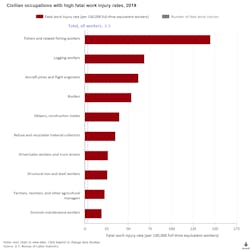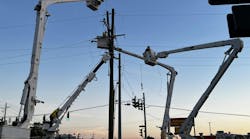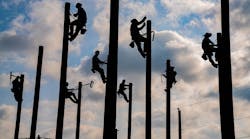The U.S. Bureau of Labor Statistics (BLS) reported there were 5,333 fatal work injuries recorded in the United States in 2019, representing a 2% increase from the 5,250 that occurred in 2018. While there is no acceptable number of fatalities, somewhat more encouraging is a reduction of more than 11 percent in the deaths in the North America Industry Classification System (NAICS) utilities sector, declining from forty-four deaths in 2018 to thirty-nine deaths in 2019. The data from 2019 obviously do not reflect the impacts of the pandemic. Will the increased distractions, mask wearing, changes in work protocols, etc. result in more fatalities in 2020 or will the heightened awareness required by workers and reduced construction activity result in less fatal accidents? Also, will our growing dependence on smart technologies be more of a factor in reducing electrical worker fatalities going forward?
Before addressing these questions, following are several statistics from BLS results from 2019. For all job classifications, transportation accidents (2,080 fatalities); falls, slips, and trips (880 fatalities); violence and other injuries caused by persons or animals (841 fatalities); and contact with objects and equipment (732 fatalities) accounted for the highest number of deaths in 2019. Like last year, the utilities sector (which includes electrical workers) thankfully did not make it into the most dangerous occupations (see graphic). Surprisingly, the most dangerous occupation is fishing, and note that construction, which includes electrical contractors, has remained on the list of most dangerous occupations. Sixty-eight electricians were among the 1,102 fatal work injuries for the construction industry sector during 2019.
The BLS has stated that occupational illnesses, including COVID-19, are out of scope for its Census of Fatal Occupational Injuries (CFOI) reporting, unless a death is precipitated by an acute injury. Even if that were the case, the agency has indicted it will not attempt to publish COVID-19-specific data because information on COVID-19-related fatalities in source data is inconsistent and often unavailable. Likewise, BLS does not intend to produce estimates specifically covering COVID-19 illnesses in its Survey of Occupational Injuries and Illnesses (SOIL) reporting. However, the agency acknowledges that COVID-19 can be a recordable illness if a worker is infected as a result of performing their work-related duties and such illness meets OSHA criteria. Even the BLS Occupational Requirements Survey (ORS), an establishment-based survey that provides job-related information regarding physical demands; environmental conditions; cognitive and mental demands; and education, training, and experience requirements for jobs, will not address changes due to the COVID-19 pandemic unless the changes are permanent for all workers in the job.
The BLS conclusion not to focus on separating out COVID-19 causation for its various work-related data profiles may be positive. It could indicate the agency believes COVID is a temporary phenomenon and will not have lasting consequences on workplace injuries, deaths, and occupational requirements. We all hope they are correct. Thankfully, the power industry has a strong record of monitoring workplace safety and striving for improvement. It may be up to the private sector to evaluate how COVID affected the incidence of injuries and fatalities in 2020, and to determine how best to prepare and equip our workforce for pandemic related events in the future. In addition, continued effort is needed to turn around the very unfavorable trend of increasing electrical worker deaths in the construction sector and to maintain the progress in the utilities sector.
Wearable smart-technology devices appear to be a made to order solution for the issues the utilities and construction sectors face. Devices that started out for recreation or novelty like personal cameras, fitness trackers and smart watches have now been customized for the workplace to provide situational and physiological data for safety and health purposes. Wearable monitors with device-to-device connectivity can detect dangerous substances, conditions, equipment and even worker to worker proximity for social distancing and contact tracing. Smart hardhats alarm if a worker is nodding off or in proximity to a falling object. Virtual reality devices allow employees to view schematics and operating protocols for devices to ensure safety is optimized and time is minimized when working in proximity to malfunctioning equipment or dangerous conditions.
Today’s IoT wearable technology allows companies to better protect workers and track behavior in the workplace to improve operating protocols, safely shorten tasks and identify risky behavior. Several companies offer packaged safety tech solutions that provide many of the above capabilities and track workplace data such as headcounts, work hours and equipment utilization. Clearly, these technologies can help companies deal with pandemic situations and continue to improve safety for our electrical workers wherever they might be performing a job. Also, thanks to safety experts everywhere for sharing COVID related best practices when they come up with new ideas!



